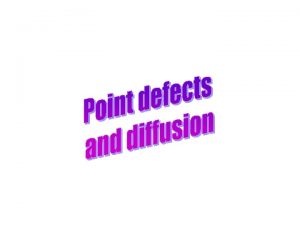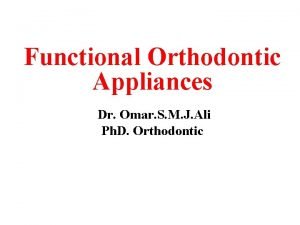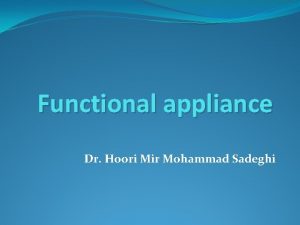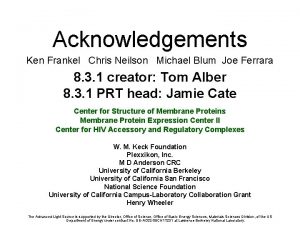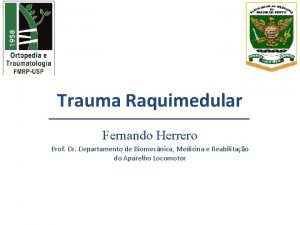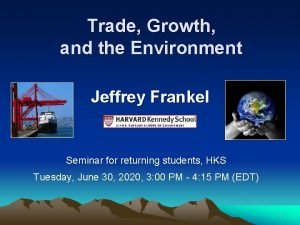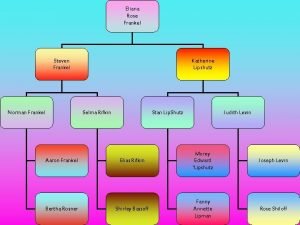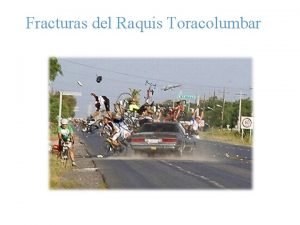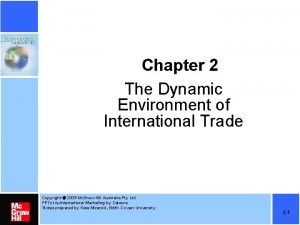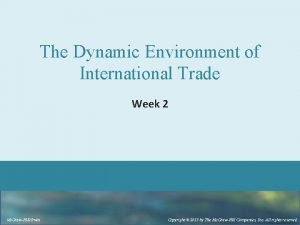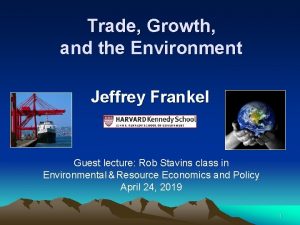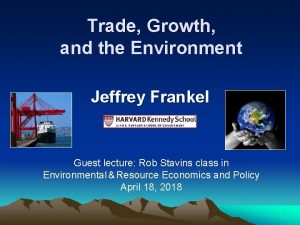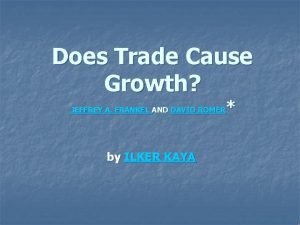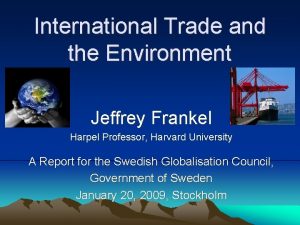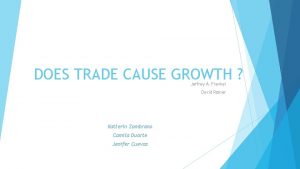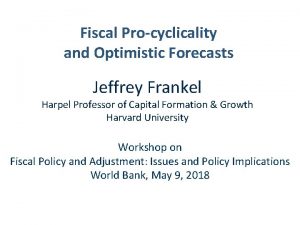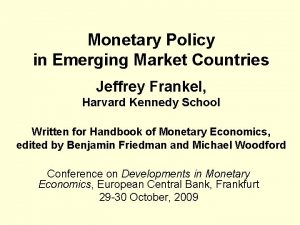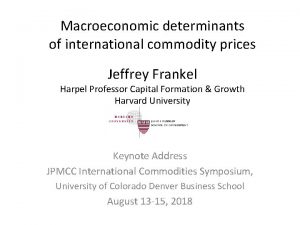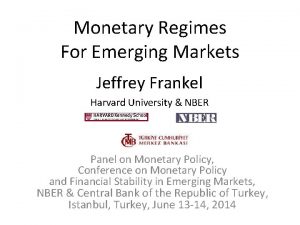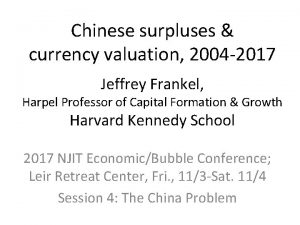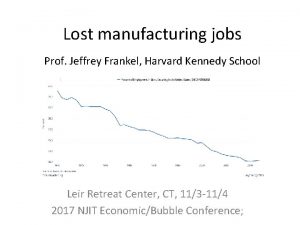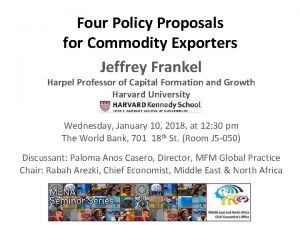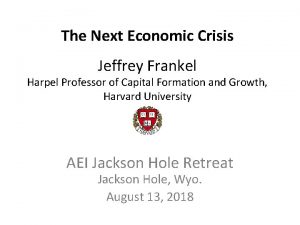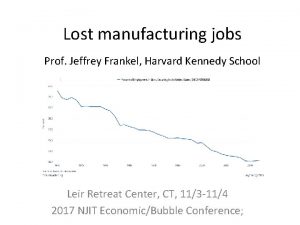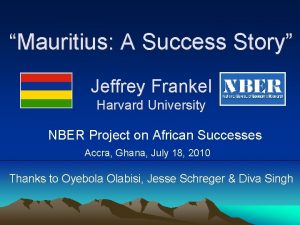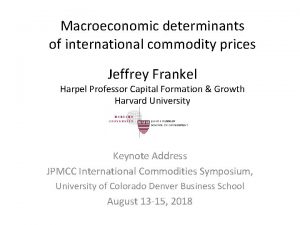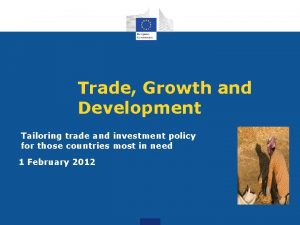Trade Growth and the Environment Jeffrey Frankel Seminar



















































- Slides: 51

Trade, Growth, and the Environment Jeffrey Frankel Seminar for returning students, HKS Tuesday, June 30, 2020, 3: 00 PM - 4: 15 PM (EDT) 1

Central question: Is trade good or bad for the environment? More specifically, is trade good or bad for the environment for a given level of GDP? 2

Outline: 1. The trade-off between GDP & environmental goals. -- Is there an Environmental Kuznets Curve? 2. Effects of trade on the environment: – Harmful – vs. Beneficial 3. Which effects tend to dominate in practice? – Correlations. For SO 2 & CO 2. – OLS estimates of effect of trade per se. – Conclusion: It depends, on domestic vs. global externalities. 3

1. Trade-off between GDP & environment Widely agreed: trade is good for economic growth • In theory: -- Classical comparative advantage (Ricardo) -- & modern theories of trade based on imperfect competition (Krugman). • Empirically: Econometric studies. – One estimate: every. 01 increase in a country’s trade/GDP ratio raises income 3 ½ % (over next 20 yrs. ). 4

But what about effects of openness on environmental quality, which is not captured in GDP statistics? 5

We care about both environmental quality and (market-measured) real income. Environmental damage ↑ • • Income per capita → • The objective, as always in economics: to attain the best “indifference curve” or “iso-welfare” curve possible, subject to physical constraints. • But environmental externalities are the classic case where the free market will not deliver the optimal tradeoff point. – Such market failure calls for government intervention. – Government regulation, if optimally designed, can deliver the optimum point (e. g. , taxing pollution). 6

Is growth per se good or bad for the environment in practice? Environmental damage Income/capita Environmental Kuznets Curve: Grossman & Krueger (1995) “Economic growth (whether trade-led or not) can improve the environment above a peak level of income. ” – EKC is confirmed for some pollution measures, e. g. , SO 2, – but rejected for some others, especially CO 2. 7

The first EKC: The London Fog (1700 -1910), i. e. , coal smoke, peaked before 1900. (though “killer fogs” continued to 1952). ) Karen Clay & Werner Troesken, 2011, "Did Frederick Brodie Discover the World's First Environmental Kuznets Curve? Coal Smoke and the Rise and Fall of the London Fog, “ in The Economics of Climate Change: Adaptations Past and Present, Libecap & Steckel. Also http: //www. air-quality. org. uk/03. php.

Average per cap CO 2 emissions, 1971 -2010 (in tonnes) But no sign of an EKC in CO 2 emissions Average GDP/capita, 1971 -2010 (in 2005 PPP dollars) David I. Stern, “The environmental Kuznets curve after 25 years, ” Journal of Bioeconomics, 2017. 9

2. Effects of trade on the environment • There are many possible effects. • They can be categorized – according to whether they: • (i) operate via GDP, analogously to investment, technology & other sources of economic growth, • or (ii) are peculiar to trade alone, and hold for a given level of GDP. – Within each category, there are effects both • beneficial for the environment, • and detrimental. 10

Is trade itself good or bad for the environment, in theory? Environmental via growth in effects of trade income: for a given level of income : Environmental K. Curve Harmful effects larger scale of “Race to the bottom” economic activity; in national regulation; Beneficial effects shifts to cleaner “Gains from trade”: techniques and e. g. , trade in green composition of goods… economic activity. 11

The feared “race to the bottom” • Environmental regulation raises the cost of doing business. • Industry & labor worry about international competition. • The more open is a country to trade, the more pressure will they exert on their government to reduce regulatory burden. • E. g. , Barrett (1994). 12

Some examples of trade helping environment • Imports of environmentally friendly products – US ended 1980 s tariffs & quotas on fuel-efficient Japanese autos, benefiting both consumer pocketbooks & air quality. – Imports of cheap solar panels from China, 2010 -17, lowered cost of solar power in US. • Trade brings technological innovation, which can, for example, save energy. • Multilateral agreements – Potential for trade sanctions, as in Montreal Protocol on stratospheric ozone depletion. – The Trans-Pacific Partnership (TPP). 13

The Trans-Pacific Partnership (TPP) • Most enviro NGOs opposed TPP from the beginning. • Did they read its enviro chapter when released in 2015? • It had, e. g. , steps to: 1) protect ocean environment from ship pollution; 2) limit subsidies for fishing fleets – which waste taxpayer money in pursuit of overfishing our oceans; 3) implement bans on trade in endangered wildlife, – insufficiently enforced under CITES, 4) & crack down on illegal logging. • For the first time in a regional agreement, these provisions were to be subject to a dispute settlement process – backed up by the threat of economic penalties. 14

Economic/environmental win-win ideas • A global ban on subsidies to fossil fuels: It would achieve both enviro goal of cutting carbon emissions and economists’ goals of cutting deficit spending & economic distortion. • Remove tariffs/quotas on environmental goods imports – The US could let in imports of Brazilian sugar/ethanol. – WTO negotiations: liberalize environmental goods trade. • 14 countries tried to pursue it plurilaterally in 2014. 15

In most countries, trade barriers are negatively correlated with CO 2–intensity of imported goods! Especially Europe. Covariance of Trade Protection & CO 2 Emission Rates, by Country Joseph Shapiro (May 2020), “The Environmental Bias of Trade Policy. ” Notes: Implicit carbon tax is the coefficient from a regression of import tariffs plus NTBs (ad valorem equivalent) on a constant and total CO 2 emission rate (tons/$), measured from inverting the input-output matrix, which accounts for both primary fossil fuels used in an industry and emissions embodied in intermediate goods used in the industry. A separate regression is run for each country. Total CO 2 is instrumented with the direct CO 2 emissions rate from the input-output table, measured in the same industry but in the 5 smallest other countries. 16 Data from year 2007. Red circles are point estimates, vertical bars are robust 95% confidence intervals.

More economic/environmental win-win ideas, continued • • Reform unilateral “trade remedies” that currently block imports of green goods. – Anti-Dumping & Countervailing Duties • Mark Wu (2014). • Especially, free up trade in renewable-energy inputs. – Almost ¾ of EU trade-remedy barriers target imports of products used for renewable energy! • Kasteng (2013). – AD remedies currently block trade in solar power inputs: • US has AD tariffs on imports of Chinese solar panels (2012, 2014). – Trump added high “safeguard” tariffs against solar panels (2018). • China has them against imports of US polysilicon (2012); • EU has penalties on imports of Chinese solar glass & panels (2013). • They should be dropped, whether by negotiation or unilaterally. 17

3. Which tend to dominate in practice: • The effects of trade that are detrimental to the environment (e. g. , race to the bottom)? • Or the effects of trade that are beneficial (e. g. , US imports of solar panels)? • It depends on what measure of environmental quality is at stake. 18

SO 2 concentrations tend to fall with openness, especially after controlling for democracy, cross-country SO 2 Democracy matters too => need effective national regulation, not just demand for clean environment. Low-democracy High-democracy Openness = Trade/GDP 19

CO 2 emissions/cap tend, if anything, to rise with openness. 20

But these rough correlations tell us little. • To isolate the effect of trade on a country’s environment, we need to control for other determinants, such as – income – democracy – population density. • Econometric analysis – Antweiler, Copeland & Taylor (2001); Copeland & Taylor (2004, 05, 13) – Frankel & Rose (2004); Frankel (2009). 21

Environmental quality equation Source: Frankel & Rose, R. E. Stat. , 2004 IV for GDP/cap: investment, education… IV for openness: geographically-based prediction of trade 22

Is trade itself good or bad for the environment, statistically? Source: Frankel & Rose (2004) Environmental via growth in income: effects of trade for a given level of income: for SO 2 EKC: after an income of about $5, 700/cap. 1990, further growth tends to reduce pollution (via national regulation) The favorable effects of trade seem to dominate. for CO 2 No sign that total emissions turn down. (CO 2 is a global externality: little regulation is possible at the national level. ) Trade may also increase emissions even for a given level of income. concentrations emissions / capita 23

Do harmful or beneficial effects of trade dominate for environmental goals? Bottom lines: • For SO 2 – at high levels of income, trade helps through both channels: via GDP & for given GDP. • For CO 2 – Even at high levels of income, trade continues to hurt. <= Absent an effective multilateral treaty, the popular will cannot be enacted. 24

Summary of conclusions • Empirical studies of cross-country data find no harmful effects of trade on some environmental measures such as SO 2 air pollution, for given income. • So globalization & the environment need not conflict. • Trade & growth give countries means to clean the air, • provided they have effective institutions of governance. • For local pollution, the appropriate governance is at the national level. 25

Summary of conclusions, continued • But trade & growth can exacerbate other measures of environmental degradation: CO 2 emissions. • The difference can be explained by the observation that CO 2 is a global externality. – It cannot be addressed at the national level due to the free rider problem. – We need institutions of governance at the multilateral level. 26

The solution • Greater international cooperation on environmental and trade issues, • to get the best of both. • One very specific example: the UNFCCC or (better) the WTO should agree on guidelines for penalties on carbon-intensive imports that countries are allowed to impose on each other. 27

28

Writings underlying this lecture https: //scholar. harvard. edu/frankel/publication-topics-new/global-environment-0 • "Congress should approve TPP, " Boston Globe, Nov. 11, 2015. • “Protectionist clouds darken sunny forecast for solar power, ” Vox. EU, 2013. • "Global Environment and Trade Policy, " in Post-Kyoto International Climate Policy, eds. Joe Aldy & Rob Stavins; Cambridge Univ. Press, 2009. • “Environmental Effects of International Trade, ” A Report for the Swedish Globalisation Council, 2009. HKS RWP 09 -006. • The Leakage/Competitiveness Issue In Climate Change Policy Proposals, ” in Climate Change, Trade and Investment: Is a Collision Inevitable? (Brookings Institution Press), 2009, Lael Brainard, ed. WCFIA WP 4792. • "Is Trade Good or Bad for the Environment? Sorting out the Causality, " with Andrew Rose, Review of Economics & Statistics 87, no. 1, 2005. NBER WP 9201. 29

Appendices • Appendix 1: Pollution haven hypothesis • Appendix 2: Anti-globalizers & the WTO • Appendix 3: Could trade measures be used in a climate change agreement? • Appendix 4: Frankel & Rose paper 30

Appendix I: Pollution havens (to p. 12) There also fears that trade will affect the allocation of pollution across countries The “pollution haven” hypothesis: trade encourages some countries to specialize in producing dirtier goods: • poorer countries • more capital-intensive countries • or less densely populated countries. • E. g. , Levinson & Taylor (2004), Aldy & Pizer (2015). 31

Appendix 2: Anti-globalizers and the WTO • The anti-globalization movement • Are WTO panel cases anti-environment? 32

The anti-globalization movement: the first big protests in Seattle, 1999 33

The anti-globalization movement, continued • Some of the anti-globalization protestors at the 1999 Seattle WTO Ministerial meeting wore turtle costumes. • Why? • They felt that a WTO panel had, in the name of free trade, blocked the ability of the US to protect Indian ocean sea turtles from shrimpers. 34

The impossible trinity of global environmental regulation Protectionism National sovereignty RACE TO THE BOTTOM An alternative Unregulated emissions Globalization Environmental standards Multilateral governance 35

What do the anti-globalizers mean when they say the WTO is an intrusive undemocratic bureaucracy? • Its governance? = the member-country governments. – Technically one-country one-vote. – True, US & EU have disproportionate weight. But making it more democratic means giving more weight to India. Result: Policy gives lower priority to the environment. • The Articles of Agreement? Hard to object to (next slide). • The WTO staff? A few thousand powerless technocrats working in a building on Lake Geneva. • WTO panel rulings that interpret the rules? That must be it. 36

WTO language supports the environment: – Article XX allows exceptions for health & conservation. – Preamble to 1995 Marrakesh Agreement establishing WTO seeks “to protect and preserve the environment; ” – 2001 Doha Communiqué: “the aims of. . . open and non-discriminatory trading system, and acting for the protection of the environment. . . must be mutually supportive. ” 37

Typical WTO panel cases • Tariffs or other measures that discriminate against producers in some trading partners, – either in favor of other trading partners (potential violation of MFN principle of Article I) or – in favor of “like products” from domestic producers (potential violation of national treatment provision of Article III). 38

Typical WTO panel cases, continued • If a targeted country files a WTO complaint alleging such a violation, the question is whether the measure is permissible under Article XX – which allows for exceptions to the non-discrimination principles for environmental reasons (XXb), – provided that the measures in question are not “a means of arbitrary or unjustifiable discrimination” nor a “disguised restriction on international trade. ” 39

Appendix 3: Could trade measures be used in climate change agreements? E. g. , the “Climate Clubs” of Nordhaus (2015)? Question (1): GHG emissions are generated by so-called Processes and Production Methods (PPMs). Does that rule out trade measures against them? No: 3 precedents + Legal scholars. Question (2): What specific trade control design is appropriate? 40

Precedent (1): Montreal Protocol on stratospheric ozone depletion • Trade controls had two motivations: – (i) to encourage countries to join, and – (ii) if major countries had remained outside, would have minimized leakage, the migration of production of banned substances to nonparticipating countries. – In the event, (i) worked, so (ii) not needed. 41

Precedent (2): The true meaning of the 1998 WTO panel shrimp-turtle decision • New ruling: environmental measures can target, not only exported products (Article XX), but also partners’ Processes & Production Methods (PPMs), • subject, as always, to non-discrimination (Articles I & III). • US was able to proceed to protect turtles, without discrimination against Asian fishermen. • Environmentalists failed to notice or consolidate the PPM precedent. 42

Precedent (3): In case there is any doubt that Article XX, which uses the phrase “health and conservation, ” applies to climate change, … • a 3 rd precedent is relevant: • In 2007, a WTO Appellate Body decision regarding Brazil restrictions on imports of retreaded tires confirmed the applicability of Article XX(b): • Rulings “accord considerable flexibility to WTO Member governments when they take trade-restrictive measures to protect life or health…[and] apply equally to … measures taken to combat global warming. ” 43

Legal scholars: WTO rules allow a tariff on carbon imports by a country enacting climate change regulation. • Cosbey, A. , S. Droege, C. Fischer, & C. Munnings (2019). “Developing guidance for implementing border carbon adjustments: Lessons, cautions, and research needs from the literature, ” Rev. Environmental Econ. & Policy, 13, 1, Winter, pp. 3– 22. • Hillman, J. (2013), “Changing climate for carbon taxes: Who’s afraid of the WTO? ” Technical report (German Marshall Fund). • Pauwelyn, J. (2013), “Carbon leakage measures and border tax adjustments under WTO law, ” in Research Handbook on Environment, Health and the WTO (Edward Elgar), pp. 448– 506. 44

Although border measures to address leakage need not violate trade principles or the WTO, • the big danger in practice is: If each country imposes border measures however suits national politics, – they will be poorly targeted, discriminatory, and often disguisedly protectionist; – they will run afoul of the WTO, and will deserve to. • A multilateral regime could guide such measures. • Some subjective judgments as to principles that should guide design of border measures…. 45

What form should border measures take? 1. Best choice: multilateral penalties. (Not likely. ) 2. Next-best: national sanctions adopted under multilateral guidelines 1. Penalties can only be applied by participants-in-good standing 2. Judgments to be made by technical experts, not politicians 3. Penalties only in 6 or 8 of the most relevant sectors (aluminum, steel, …). 3. Third-best choice: No border measures. 4. Each country chooses carbon tariffs as it sees fit. 5. Worst choice: national measures are subsidies (e. g. , free permits) to adversely affected firms. 46

Appendix 4: Frankel & Rose (2005) • Equations estimated: – Growth equation (using gravity variable as IV for trade openness) – Environmental quality equation (using factor endowments as IV for growth) 47

Construction of IV for openness First-stage regression of gravity equation • log(Tradeij/GDPi) = -. 94 log(distanceij) + . 82 log(popj) +. 53 Languageij (. 05) (. 02) (. 11) +. 64 Borderij - . 27 log(Ai. Aj) - . 47 # Landlockedij + uij (. 21) (. 01) (. 08) • Equation estimated for 1990. • Number of Obs. = 4052. • R 2 =. 28 (Robust standard errors in parentheses. ) Computation of Instrumental Variable • Take exponent of fitted values of bilateral trade and sum across bilateral trading partners: j exp [Fitted log(Tradeij/GDPi) ]. • Correlation (trade ratio, generated IV) =. 72 48

Measures of environmental damage • SO 2: sulphur dioxide, mean (in micograms per cubic meter), 1995 • NO 2: nitrogen dioxide, mean (in micograms per cubic meter), 1995 • PM: Suspended Particulate Matter, mean total (in micograms per cubic meter), 1995 • Water: Rural Access to Clean Water • Def: annual deforestation, average percentage change, 1990 -95 • Energy: Energy depletion, in percent of GDP (“genuine savings”)[1] • CO 2/capita: Carbon dioxide emissions, industrial, in metric tons/cap [1] Energy depletion is a measure computed for the World Bank’s World Development Indicators. It is equal to the product of unit resource rents and the physical quantities of fossil fuel energy extracted (including coal, crude oil, and natural gas). Table 3. 15, http: //www. worldbank. org/data/wdi 2001/pdfs/tab 3_15. pdf. 49

I updated the Frankel-Rose econometric analysis • in a 2009 paper for the Swedish Globalisation Council -- putting together data for 1990 -2004, -- for 158 countries. • EKC (inverted U) shows up for PM 10 and water pollution. • Trade still appeared to worsen CO 2. • Again, the obvious explanation: lack of a comprehensive global climate agreement. 50

The author acknowledges • valuable input from Joseph Aldy, Scott Barrett, Jagdish Bhagwati, Thomas Brewer, Steve Charnovitz, Arik Levinsohn, Gary Sampson & Robert Stavins; • and support from – the Harvard Program on International Climate Agreements – a Faculty Grant in Sustainability Science from Harvard’s Center for International Development, – as well as from the Government of Sweden. 51
 Jeffrey frankel harvard
Jeffrey frankel harvard Trade diversion and trade creation
Trade diversion and trade creation Umich
Umich Which is the most enduring free trade area in the world?
Which is the most enduring free trade area in the world? Trade diversion and trade creation
Trade diversion and trade creation Liner vs tramp
Liner vs tramp What is plant growth analysis
What is plant growth analysis Monocots vs eudicots
Monocots vs eudicots Primary growth and secondary growth in plants
Primary growth and secondary growth in plants Chapter 35 plant structure growth and development
Chapter 35 plant structure growth and development Dorsolumbar vertebrae
Dorsolumbar vertebrae Schottky and frenkel defects
Schottky and frenkel defects Dr omar orthodontist
Dr omar orthodontist Fränkel 2 appliance uses
Fränkel 2 appliance uses Frankel's behaviour rating scale
Frankel's behaviour rating scale Frankel signal to noise
Frankel signal to noise Choque medular
Choque medular Stanley frankel
Stanley frankel Aaron frankel
Aaron frankel Clasificacion ao fracturas vertebrales
Clasificacion ao fracturas vertebrales Jeff eldred
Jeff eldred The trade in the trade-to-gdp ratio
The trade in the trade-to-gdp ratio Fair trade not free trade
Fair trade not free trade Ted talk atlantic slave trade
Ted talk atlantic slave trade Growthchain
Growthchain Geometric growth graph
Geometric growth graph Neoclassical growth theory vs. endogenous growth theory
Neoclassical growth theory vs. endogenous growth theory Difference between organic and inorganic growth
Difference between organic and inorganic growth Dynamic environment of international trade
Dynamic environment of international trade The dynamic environment of international trade
The dynamic environment of international trade Environment of business finance
Environment of business finance Hình ảnh bộ gõ cơ thể búng tay
Hình ảnh bộ gõ cơ thể búng tay Frameset trong html5
Frameset trong html5 Bổ thể
Bổ thể Tỉ lệ cơ thể trẻ em
Tỉ lệ cơ thể trẻ em Gấu đi như thế nào
Gấu đi như thế nào Tư thế worm breton là gì
Tư thế worm breton là gì Chúa yêu trần thế alleluia
Chúa yêu trần thế alleluia Các môn thể thao bắt đầu bằng tiếng đua
Các môn thể thao bắt đầu bằng tiếng đua Thế nào là hệ số cao nhất
Thế nào là hệ số cao nhất Các châu lục và đại dương trên thế giới
Các châu lục và đại dương trên thế giới Cong thức tính động năng
Cong thức tính động năng Trời xanh đây là của chúng ta thể thơ
Trời xanh đây là của chúng ta thể thơ Mật thư tọa độ 5x5
Mật thư tọa độ 5x5 Phép trừ bù
Phép trừ bù độ dài liên kết
độ dài liên kết Các châu lục và đại dương trên thế giới
Các châu lục và đại dương trên thế giới Thơ thất ngôn tứ tuyệt đường luật
Thơ thất ngôn tứ tuyệt đường luật Quá trình desamine hóa có thể tạo ra
Quá trình desamine hóa có thể tạo ra Một số thể thơ truyền thống
Một số thể thơ truyền thống Cái miệng xinh xinh thế chỉ nói điều hay thôi
Cái miệng xinh xinh thế chỉ nói điều hay thôi Vẽ hình chiếu vuông góc của vật thể sau
Vẽ hình chiếu vuông góc của vật thể sau











